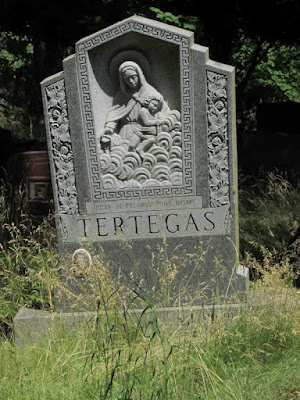Emil Ambos *1844, 1898†
Emil enjoyed life. His parents were from German lands. His father became Columbus' first candy maker, and later a banker. Emil went to Center College Pennsylvania, and Ohio's Kenyon college. He retired at 39, after being a saloon keeper and alcohol wholesaler. He kept a stable of horses, lived luxuriously, and really enjoyed fishing. He was generous towards poor children, especially around Christmas. Ambos was recognised as a philanthropist.

Ambos had a 17 page will, the longest in county's history at that date. He set aside five thousand dollars for a bronze statue of himself in his fishing clothes. The sculptor, John Francis Brines cast the bronze in 1901. In 2019, the Smithsonian thought the statue important, and it needed restoration. There was a bullet hole in Emil's head, his trout were taken, and the bronze had gone green, and in bad shape. That year the statue was restored by Michael Major. In the last few years a few major restorations are taking place at Green Lawn. The Schumacher sarcophagus was cleaned, and restored that same summer. Those two monuments are near each other in Section M.
During my two visits, the sun was behind Emil, and very strong. It was not easy to get a clear foto.
Samuel "Chief" Gabriel *1912, 1980†
_____________________________________________________________________(DO NOT GIVE OUT LOCATION)
This is a fotocopy of a portion of a page of notable burials in Green Lawn Cemetery. There were too many undertakers listed, several Ohio governors, Columbus businessmen, speculators, and capitalists; but the only one with a stage direction was Snook.
There turns out to be a tawdry, salacious tale of murder involved in keeping the spot a secret. James Howard Snook was a professor of veterinary surgery at the land grant school in the state's capital. He won two gold medals in team pistol at the Antwerp 1920 Olympics. Snook killed his student mistress in 1929, outside a firing range, near campus. He used a ball peen hammer, and a pocket knife.
Theora Hix was working as a school stenographer at the veterinary college to pay for her education there. For three years the two had a wild affair. Snook was married, and she was very sexually active. Theora wanted Snook divorce, and threatened to kill members of Snook's family.
Snook gave a forced confession. He was checked for syphilis by a botched spinal tap, that caused enduring pain. That doctor was not as adept with the tools of trade. Snook had given himself a vasectomy, so that Theora would not have a child by him. Later, the final cut he made was a precision slice of Hix's throat.
The trial was a national incident. Snook sat in a beach chair for the trial. The jury took 28 minutes to find him guilty, although she was reaching for a derringer in her purse. I read, a short article that stated laws were changed because of the irregularities in his prosecution. Trial testimony was published, with some of the sex details omitted.
Later, the warden of the prison made up a story of Snook's confession. Snook was executed early in 1930. He was buried under a small grass hugging stone with the name James
Howard. His wife, and daughter took a new surname. Ohio Exploration
Society says that for 75 years his grave site was a secret.
The snook hook is used in the spaying and neutering of dogs and cats. James Snook created the first one.





















































